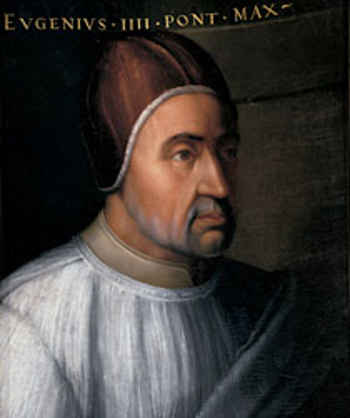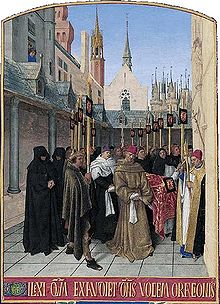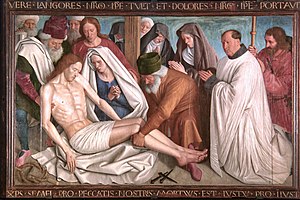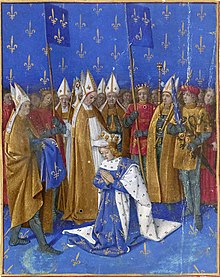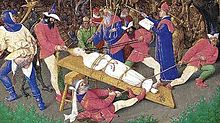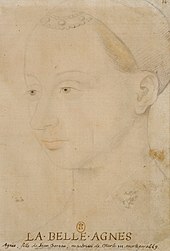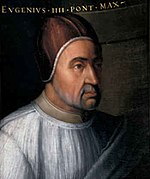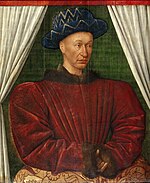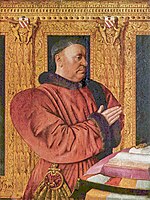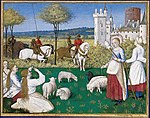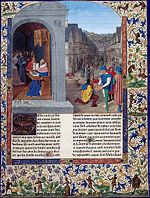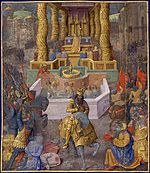Jean Fouquet
Jean Fouquet (* around 1420 in Tours ; † between 1478 and 1481) was a French book and panel painter . He is considered to be one of the most important artists on the threshold from the late Gothic to the early Renaissance .
Little is known of Fouquet's early years. Research has moved away from viewing the studio of the so-called Bedford master in Paris as a place of training and today suspects more of an apprenticeship with the so-called Jouvenel master , who is probably based in Nantes , whose works were once considered to be Fouquet's youthful works. Between 1445 and 1447 Fouquet traveled to Italy and met Fra Angelico , Filarete and other Renaissance artists of the Quattrocento in Rome , whose influence can be demonstrated in later paintings. Since the 1450s he was in the service of King Charles VII and Louis XI. , whose court painter he became in 1475. His clients included numerous high officials of the state such as the chancellor Guillaume Juvénal des Ursins and the king's treasurer, Étienne Chevalier .
For this he created the so-called Book of Hours by Étienne Chevalier (after 1448) and the Diptych by Melun (around 1455), two of the most famous works of French book and panel painting of the 15th century. An enamel medallion with a self-portrait of Fouquet on the frame of the diptych is evidence of his self-confident artist individuality. Other outstanding works are illustrations of the so-called Munich Boccaccio (around 1458), the Grandes Chroniques de France (around 1459) and in the manuscript of the Antiquités judaïques completed around 1465 , in which an entry identifies François Robertet's Fouquet as an illuminator . Since the 1460s, the manuscripts illustrated by Fouquet can be traced back to employees who indicate a high-performance workshop. Up to 1478 Jean Fouquet can be traced back to Tours, in 1481 he is described as dead there.
Fouquet's work is regarded as an independent synthesis of the French painting tradition, the Italian early Renaissance and Dutch realism . In particular, the perspective constructions, the use of light and the historical accuracy of his pictures show Fouquet to be one of the most important painters of his time. Numerous mentions in early art literature and in documents provide information about the high reputation Fouquet enjoyed in both France and Italy. The number of preserved book illuminations clearly exceeds that of the panel paintings, but the attribution of some works to Fouquet's own oeuvre is controversial.
Youth and early years
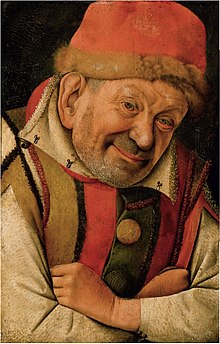
Jean Fouquet was born in Tours between 1415 and 1422 . François Robertet, secretary of the royal son-in-law Pierre de Beaujeu , attests to his birthplace around 1500 in the colophon of a manuscript of the Antiquités judaïques illustrated by Fouquet . The year of his birth, on the other hand, can only be roughly estimated by dating his first pictures and by a self-portrait of Fouquet on the frame of the Melun diptych from around 1455 .
Fouquet's training and early work are the subject of a decades-old scientific controversy that has not ended to this day. For a long time, the book illustrations were attributed to the so-called Jouvenel master Fouquet, but now a distinction is made between the two artists. Eberhard König in particular made an effort to separate the hands of the related works and believes that Fouquet's apprenticeship from the Jouvenel master, who may be based in Nantes , is likely. The older Fouquet research, following Paul Durrieu , which still has followers today, assumes, however, that he received his training in Paris, possibly with the so-called Bedford master . Claude Schaefer put forward the hypothesis that Fouquet could have learned from the court painter Jacob de Litemont .
Fouquet's early book illuminations have not yet been proven and it seems questionable whether he made any illustrations before his trip to Italy or whether he initially only painted portraits. He must, however , have been familiar with older works in the libraries of Tours and Bourges . In particular, the illustrations by the Boucicaut master and the Bedford master show stylistic similarities to later works by Fouquet. The fact that he later retouched illustrations by the Boucicaut master for Etienne Chevalier fits into these interrelationships.
Fouquet's earliest surviving work is considered to be a portrait of the court jester Gonella, the creation of which is believed to have taken place before his trip to Italy. The style analysis reveals an intensive examination of the portrait art of the Dutch masters , such as Jan van Eycks . Like the portraits of the Flemings, the portrait of the fool shows an almost exaggerated realism. What kind of connections were Fouquet to the art of the southern Netherlands , whether he knew the Ghent Altarpiece by Jan van Eyck or its portraits from first hand, cannot be proven.
Stained glass can also be considered an important influence on Fouquet's treatment of light and color , particularly that of the cathedrals of Tours and Bourges . Painted free sculptures could have been just as important . It is known about Fouquet himself that he painted the death mask of Charles VII designed by Litemont . Such dependencies cannot, of course, be examined precisely, since hardly any colored versions of sculptures have survived.
Italy trip
As a young painter, Fouquet traveled to Rome and thus opened the tradition of great artists' journeys to Italy. It is not clear whether he took the expensive and time-consuming journey as a companion on a diplomatic mission or undertook it for personal reasons and financed it privately. 1445 is considered to be the earliest date for Fouquet's trip to Rome, as his later work shows influences by Fra Angelico , who had been working in Rome since May of this year.
Fouquet painted a no longer preserved portrait of Pope Eugene IV with two confidants on canvas . The portrait was above the door of the sacristy of the monastery of Santa Maria sopra Minerva , in which Fra Angelico also lived. In order to receive such a commission, Fouquet certainly already had the recognition of an artist who had mastered the virtuoso and lifelike portraiture of the southern Dutch, which was admired in Italy.
Besides Fra Angelico, Fouquet got to know Filarete , who years later praised him as buen maestro maxime a retrarre del naturale . Without a doubt, Fouquet also met modern Italian artists such as Benozzo Gozzoli , Brunelleschi or Donatello and studied at least older ones like Masaccio .
Another important impression, often recurring in later book illustrations, was the ancient and contemporary buildings of Rome and Florence , which he must have visited on the way there and back. In Florence in particular he was able to take up the new developments of the early Italian Renaissance . The sketch after nature, which Fouquet earned an isolated position in the French art of his time, he will also have used for the study of antiquity. Since Fouquet painted a detailed reproduction of the Roman Forum as the background in the illustrations for the so-called Livy of the Sorbonne, for example , he must have created sketchbooks or sample books on his trip to Italy.
In 1448 Fouquet leased a residential tower belonging to the Chapter of St. Martin in Tours . At this point at the latest, he must have returned to France.
Orders in the vicinity of King Charles VII.
Most of Fouquet's surviving pictures and book illuminations were created between 1450 and 1460 and thus fall between his return to France and the death of King Charles VII (July 22, 1461). Fouquet is likely to have married during this period. Fouquet's clients come from the high service nobility at the court of Charles VII.
In the 1450s he created two of the most outstanding works of French art in the 15th century for the royal treasurer Étienne Chevalier : the illuminations in the so-called Book of Hours of Étienne Chevalier and the large-format diptych by Melun . Fouquet portrayed his client in both works, each in a praying posture with his patron saint, St. Stephen .
Even Jean Bernard († 1466), Archbishop of Tours and close confidant of the king and the Anjou seems to have been on friendly terms as principal with Fouquet. In his will he gave this a commission. Fouquet will have been introduced to the king's court through high-ranking clients such as Étienne Chevalier and Jean Bernard.
Etienne Chevalier's Book of Hours
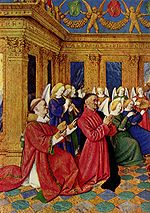
|

|
Book of hours by Étienne Chevalier
Étienne Chevalier with Saint Stephen in prayer in front of the enthroned Maria lactans .
The so-called Book of Hours of Étienne Chevalier is set after Fouquet's return from Italy and was probably completed before 1457, since he had other important commissions to carry out from this time. The collaboration of a journeyman is visible in the miniatures, one picture remained unfinished. Because of Fouquet's masterly mastery of spatial representation and lighting, as well as the liveliness and originality of the miniatures, the book illuminations have always been considered not only a major work by the artist, but also the illumination of the 15th century.
The book of hours remained in the Chevalier family until it was sold and cut apart at the end of the 18th century, so that today only 47 individual miniatures have survived, most of which are trimmed to the edge of the picture and stuck on wooden panels. Forty sheets came from the possession of the Brentano family , which they acquired in Basel in 1805, to the Musée Condé in Chantilly Castle . Seven other miniatures are in the Bibliothèque nationale de France , in the Louvre and the Musée Marmottan in Paris, in the London British Library and in Upton House as well as in the New York Metropolitan Museum . A sheet of text discovered in 1981 allows the rough outline of the book to be reconstructed.
The founder is shown on the frontispiece, similar to the later diptych of Melun, together with Stephanus in front of the enthroned Mary, and on another miniature as a prayer at the burial of Christ. His name Maistre Estienne Chevalier and his monogram are included in numerous places in the illustrations.
In contrast to later manuscripts, Jean Fouquet executed all or almost all of the illustrations by hand. This is an indication of an early approach to the manuscript, when Fouquet did not yet have an efficient workshop, and at the same time a reason why the miniatures in this manuscript are executed at such a consistently high level.
Several miniatures are divided into two image fields in an innovative way. The upper one presents the main motif, in the lower one there are secondary scenes or even fantasy creatures, as one often finds in the gothic book illumination in fringe drama .
The portrait of King Charles VII
With the portrait of Charles VII hanging in the Louvre today - possibly the first official portrait of a French ruler - Fouquet seems to have risen to become the king's painter around 1453, provided it was a commission from Charles and was not created in his vicinity. An argument against a personal commission from the king is that such a portrait would probably have been made by the court painter Jacob de Litemont under normal circumstances . After all, even after the king's death in 1461, Litemont ordered Fouquet to color the death mask he had made for Charles, as can be deduced from an account of the funeral costs.
Fouquet depicts the king in his oratorio in the Sainte-Chapelle in Bourges . There is evidence that it hung there in the 18th century, but whether it originally had its place in the Sainte-Chapelle is not known. Praying, two small ruffled curtains on either side of the picture frame, Karl appears isolated. Illuminated by a light source on the left outside the picture and against a dark green background, the figure of the king is depicted extremely vividly and realistically in a lush red velvet robe. The effect of the portrait varies depending on the location of the viewer.
Posterity wanted to see Fouquet's devastating judgment of the king in the portrait, but as Schaefer was able to show, this interpretation of the picture is more influenced by the negative judgment of the recipients about Charles VII. Rather, the picture is an unbiased historical document that is characterized by realistic and non-idealizing observation. The king's right cheek is swollen and already shows the effects of the swelling of the lower jaw from which the king died.
The Pietà in Nouans-les-Fontaines
Fouquet's authorship for the Pietà in Nouans-les-Fontaines near Loches was recognized in 1932 by P. Vitry. Nothing is known about the client, shown kneeling in the picture but outside of the action, except that he must have been a canon according to his clothing and was probably called Jacques because of the patron saint Jacobus standing behind him .
The actual pictorial scene, the group of lamentations, only takes up the roughly square left half of the panel, while the donor's portrait appears as a later, commission-related addition. The picture will have been designed as an altarpiece . This is supported by the connection between the motif and the original inscription ( vere langores nostros ipse dolores nostros ipse portavit Christ semel pro peccatis nostris mortuus est justus pro injustis ) to the Eucharist .
The evaluations of the devotional image diverge unusually wide - from a comparable meaning of the Pietà for French and the Ghent Altarpiece for Dutch art to the judgment that drawing and modeling are weak and carried out by a colleague of Fouquet.
In 1981 the picture, painted on nine walnut boards, was cleaned and restored in the Louvre. Infrared recordings were also made, which could clarify questions about the technical implementation. In this way it was possible to dispel any doubts that the very precise preliminary drawing was by Fouquet. Between the extremes of an early dating of the picture around 1450 and its classification in Fouquet's late work, the early approach has largely prevailed.
The Book of Hours of Simon de Varie
It was not until 1984 that L. Marrow discovered a fragment of a book of hours in San Francisco with four full-page illustrations by Fouquet, which he was able to associate with two miniatures of another fragment in The Hague.
The client with the initials TR is unknown, the second owner could be identified by his coat of arms as the marshal of the royal stables, Simon de Varie, who had been raised to the nobility by Charles VII. Around 1455 he subsequently commissioned the six illustrations by Fouquet and was reproduced by him kneeling in front of Mary on the frontispiece in a praying posture. For this, Fouquet used a representation pattern that he had also used in Etienne Chevallier's book of hours: the donor occupies a whole page, the enthroned Our Lady is depicted on the opposite. As a result, the miniatures, which are reminiscent of large-format panel paintings from the room layout, are connected to form a diptych. With the diptych by Melun and probably the portrait of Guillaume Juvénal des Ursins, two panel paintings by Fouquet have been preserved that are conceived in an analogous manner.
Two other miniatures by Fouquet are heraldic masterpieces, another is an iconic bust of the Madonna. The remaining 49 illustrations come from two contemporary Parisian illuminators, the so-called Dunois master and the master of Jean Rolin , who succeeded the Bedford master . A later owner of the manuscript divided the manuscript into three parts in the 17th century.
Diptych of Melun
The diptych by Melun is a two-part panel painting ( diptych ) that Jean Fouquet painted for Étienne Chevalier around 1456. The left wing of the devotional image is now in the Berlin Gemäldegalerie , the right in the Koninklijk Museum voor Schone Kunsten in Antwerp. The diptych used to hang over the grave of Étienne Chevalier's wife Catherine Budé in the Collegiate Church of Notre-Dame in Melun .

|

|
Diptych by Melun
Left wing: Etienne Chevalier with St. Stephen (Berlin Gemäldegalerie)
Right wing: The enthroned Madonna with the Christ child (Royal Museum of Fine Arts, Antwerp).
The client kneels on the left wing in prayer next to his namesake, St. Stephen . The name Estienne is carved in golden letters on the marble pillar behind the head of the founder. The palatial room is designed entirely in the style of the Italian Renaissance , possibly it is an image of the treasurer's house, which is described as particularly splendid. He is dressed in a rich, fur-trimmed red coat. Stephen is shown with his attributes : a stone that inflicted the fatal head wound on him during his martyrdom, which is also shown in the picture, and a book of the Gospels on which the stone rests. The oak wing has a size of 93 × 85 cm. The right half of Étienne Chevalier's face and a large part of Stephen's robe were damaged and painted over. A thorough restoration took place in 1983.
The right wing represents a completely different, supernatural sphere, which is kept entirely in the colors blue-white-red: The Madonna with the baby Jesus is enthroned in front of a group of red and blue seraphim and cherubim , which carry the ruler's chair. Her bare left breast corresponds to the motif of Maria lactans , the nourishing Mother of God, but Mary does not suckle the Christ child on her lap. This points with the left index finger at the donor as a sign that his prayers and intercession are heard. The Antwerp grand piano, like the Berlin one made of oak, measures 91.8 × 83.3 cm.
According to an inscription dated 1775 on the back of the picture and a statement by Denis Godefroy in the middle of the 17th century, Mary is said to have the features of Agnès Sorel , King Charles VII's mistress , who died in 1449. Her contemporaries considered her the “most beautiful woman in the world” and as such dressed provocatively so that a bishop complained about her décolleté, which exposed the view down to the nipples. Étienne Chevalier was also strongly encouraged by Agnès and is said to have been fond of her. The identification of the Madonna with the king's mistress determines the history of the reception of the picture to this day, although Schaefer was able to show in 1994 that it is most likely a legend. Instead, the representation of the Madonna follows an impersonal ideal of beauty of the time. Fouquet's contemporaries are unlikely to have found the bare breasts or the possible portrayal of the king's mistress as Mother of God as blasphemy or lascivious. On the one hand, the Maria lactans was an old pictorial motif, on the other hand, Agnès was considered a woman who had rendered outstanding services to France and had moved the king to fight against England in a similar way as Johanna von Orléans in 1429 .
Technical painting studies revealed that under Fouquet's portrait of King Charles VII there was also a Madonna similar to Melun's. Claude Schaefer therefore suspects that Fouquet interrupted and postponed the work that had already started because of the royal commission.
For centuries, the picture was in the Church of Notre Dame in Melun , the native city of Étienne Chevaliers south of Paris. It hung over the grave of Étienne Chevaliers and his wife, who had died before him, and was supposed to preserve his memory “forever”. For this purpose he donated the picture and made sure in his will that a soul mass was read for him every morning at six o'clock . When the canons needed money to restore their church in 1775, they sold the picture against the will of the donor.
After the French Revolution, the individual parts of the diptych appeared in the art market. An Antwerp mayor bought the right wing in Paris, and it has been in the Koninklijk Museum voor Schone Kunsten in Antwerp since 1840. The German romantic poet Clemens Brentano discovered the left wing at an art dealer in Basel. Brentano was the first to recognize the resemblance to the miniatures in the book of hours by Étienne Chevalier, which was in the possession of his brother, the Frankfurt banker Georg Brentano, and which had only recently been ascribed to Fouquet. In 1896 the picture came to the Berlin Gemäldegalerie.
The concrete knowledge that the Berlin and Antwerp pictures belong together was lost after the sale in 1775, but corresponding assumptions were made again. This was confirmed in 1981 by tests on the wood of the diptych parts - two boards from the Berlin board and one board from the Antwerp board come from the same oak that was felled around 1446.
Fouquet's self-portrait

|
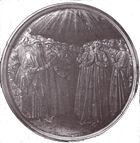
|
Enamel medallions.
Self-portrait of Jean Fouquet (Paris, Louvre) and
appointment of widow carers (formerly Berlin, Museum of Applied Arts, loss of war).
A famous self-portrait by Fouquet on an enamel medallion now in the Louvre in Paris is the rare case of a signed self-portrait by a 15th century artist. The medallion probably comes from the frame of the diptych. This is also assumed for a second enamel from the Kunstgewerbemuseum Berlin , which was lost in World War II. In 1661, the historian Denis Godefroy described the diptych in detail, which he still saw in its original location in the collegiate church, and also mentioned medallions in the frame. It is probable that the two copies in Paris and Berlin are from Melun, but it cannot be proven with absolute certainty. Both the inclusion of the medallions and the idea of memorializing yourself with a self-portrait is unusual for French painters of the 15th century and goes back to models of the Italian Renaissance, particularly Filarete . The diameter of Fouquet's round self-portrait is 6.8 cm, the medallion in Berlin was 7.5 cm in diameter.
Grandes Chroniques de France
Under the signature Bibliothèque nationale de France , Manuscrit français 6465, there is a manuscript from the Grandes Chroniques de France , which Fouquet illustrated with 51 miniatures around 1459.
The large folio volume bound in heavy morocco leather still contains 457 parchment leaves in the format 46 × 35 cm. Three sheets of the original manuscript are missing, including the first sheet. The text of the chronicle comes from two different scribes, the first 240 sheets were probably written in the first third of the 15th century, the rest around 1460. In the second part of the manuscript, the space left out in the text into which Fouquet inserted his miniatures is not more square, but upright rectangular. The initials were until fol. 119v executed in the period around 1410 to 1430, later the rest was added.
Eight miniatures depict the visit of the German Emperor Charles IV of Luxembourg to his nephew, King Charles V of France . 22 images show detailed city views: Paris and Île-de-France are shown 16 times , Tours can be identified twice , Rome , Melun , Gisors and Châteauneuf-de-Randon each .
Since the first sheet is missing in the manuscript, there are no direct references to the conditions of origin and the client or early owner. Since the text served to glorify the royal family, the order for the representative manuscript from the environment of King Charles VII probably came from him himself. Fouquet then also focused on the display of the French royal family. A large part of the pictures depict solemn entrances, banquets, coronations and funeral ceremonies, as well as a considerable number of battle scenes. Fouquet made most of the miniatures by hand and did not leave the work to the employees of his workshop, making the work one of the most outstanding book illustrations. In particular, the meticulous attention to detail, masterful lighting effects and the background design with precisely reproduced city landscapes make the representations come alive despite the limited subject matter. The azure blue with numerous highlights in gold, which dominates almost all miniatures, is to be understood as a heraldic symbol of the French monarchy.
For stylistic reasons, the images in the manuscript are placed near the Munich Boccaccio , also illuminated by Fouquet , which must have been illustrated shortly after 1458. There is some evidence that an invoice from King Charles VII for the scribe and chronicler Noël de Fribois for work on a copy of the Grandes Chroniques de Frances in August and September 1459 on the manuscript fr. 6465 refers.
Numerous marginal notes from the 16th or 17th centuries show that the manuscript was read intensively, but there are no more precise indications of its fate. Nothing is known even about the acquisition of the important manuscript by the Bibliothèque nationale , neither a date of receipt nor a previous owner are recorded. The stamps of the National Library indicate that the manuscript was first registered there between 1815 and 1830 - at that time, however, it could have been acquired several years ago.
The Munich Boccaccio
We are exceptionally well informed about the circumstances of the creation of the famous so-called Munich Boccaccio . Laurent Gyrard, a brother-in-law of Étienne Chevalier, had Des Cas des Malheureux Nobles Hommes et Femmes copied by the parish priest Pierre Favre in Aubervilliers near Paris, who stated in the colophon November 24, 1458 as the date of completion of the manuscript. The text is a translation of Boccaccio's De casibus illustrium virorum et mulierum by Laurent de Premierfait . This anecdotal history book about the wheel of Fortuna , originally written in Latin, has been one of the most popular books of the European nobility in various translations since the beginning of the 15th century.
Fouquet's iconographic plan differs from all of the other 24 illustrated codices in the text; the emphasis of the illustrations is entirely on the present and recent history. This special interest is particularly expressed in the frontispiece miniature, which illustrates an event in the summer of 1458: shortly after his testimony during the rehabilitation of Joan of Arc , Duke John II of Alençon was sentenced to imprisonment at Loches Castle and lost the post of lietenant General to that Duke Louis of Bourbon , who had made his castle in Vendôme available to King Charles VII and the Parliament , the highest court of justice, for the lit de justice . This political process was of particular importance for the high nobility of France and the illustration was ordered from Fouquet by the client Gyrard as a current document.
One suspects that the figure on the right edge of the picture, looking at the viewer in the extension of the door frame, is a self-portrait of Fouquet. The unusual perspective solution of the courtroom, the vividly portrayed figures of contemporary history and the ingenuity that reaches down to the smallest detail make the miniature one of the most remarkable historical pictures in book illumination.
A considerable number of the miniatures did not come from Fouquet himself, but from talented employees in his workshop. One of them bears the emergency name Meister des Münchner Boccaccio according to this manuscript and can be traced back several times in later illustrated manuscripts. This artist may be a son of Jean Fouquet, Louis or François.
At the court of Louis XI.
Louis XI. , declared opponent of his father, had a completely different relationship to art than Karl, for him it was entirely in the service of political ends. While Ludwig dismissed most of Charles' confidants immediately after his death in 1461, Étienne Chevalier and Guillaume Jouvenel remained in office, so that Fouquet's position was probably not too shaken. One can only assume that he gradually built up a larger workshop that his sons could also have worked on. Jacob Litemont continued to occupy the rank of court painter, but in 1475 - towards the end of his life - Fouquet was finally referred to in a bill as peintre du Roy . However, there is no large-format portrait of the king that was made by Fouquet.
The portrait of Guillaume Juvénal des Ursins

|
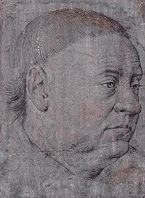
|
Portrait of Guillaume Juvénal des Ursins (Paris, Louvre)
and preliminary study (Berlin, Kupferstichkabinett).
Guillaume Juvénal des Ursins , Chancellor under Charles VII and, after a brief impeachment, under Louis XI, commissioned Fouquet with a picture of which only the left part has survived. Juvénal des Ursins was considered one of the greatest benefactors of Tours Cathedral , and the picture may have been hanging over his grave there. In some respects it is comparable to the Melun diptych and, like this one, originally belonged to a diptych or - less likely - to a triptych. It is likely that he knew the picture of Étienne Chevalier, since both belonged to the same group of the official nobility at the royal court and frequented the same early humanist circles. A wood-biological examination of the oak boards determined the felling date to be 1460, so that the panel is likely to be painted around 1465 or shortly thereafter.
The picture shows the about sixty-year-old praying donor in a three-quarter view in a red robe, like the one King Charles VII wears on his portrait. The Chancellor holds his devotions proudly rather than humbly in a representative gold-paneled room. A wallet on the belt increases the impression of the splendor that surrounds Juvénal des Ursins. On the two ornate antique-style pilasters of paneling worn as capitals elaborated bears symbols of the Juvénal family, the coat of arms. The pillow that carries a missal or book of hours in front of the founder shows the colors of his family: gold, white and red.
In 1910 Max J. Friedländer discovered a chalk sketch by Fouquet in the Berlin Kupferstichkabinett , which was a direct preliminary study for the portrait, even if it was not transferred unchanged into the portrait.
Illustrations of the Jewish antiquities of Flavius Josephus
The Antiquités judaïques des Flavius Josephus were hardly missing in any French library of the high nobility. Such a manuscript was also produced for the Duc Jean de Berry , but the illustration by the Josephus Master was canceled after the Duke's death in 1416 after only three completed miniatures. In 1465 the heir of the manuscript, Jacques d'Armagnac-Nemours , visited Tours and will have commissioned Fouquet to complete the representative manuscript . He added eleven large-format, monumental miniatures, each over 20 cm high and 17-18 cm wide.
In the illustrations of the Jewish Antiquities, too, Fouquet combines historical details with modern appearances. He depicts the construction of the Temple of Jerusalem as contemporary architecture in the style of the late Gothic flamboyant , of which the cathedral in his hometown, which at that time was still without a tower, is a particularly impressive example. At the same time, the illustration is based on a careful reading of the text, so the proportions and the golden facade of the temple exactly match the description. From the details of the picture, insights into the working method of Fouquet's workshop can be gained, which does not deviate from the usual practice of medieval illustration workshops: The figures in the foreground are of poor quality compared to other works by Fouquet and allow the conclusion that the master designed the picture and sketched it out, but the elaboration was at least partly done by employees. This phenomenon, which is recurring in many works, often makes exact attribution and the separation of hands very difficult. What is striking in all of the miniatures of the manuscript is the complete absence of anti-Jewish tendencies in the pictorial program, which is atypical of the time, which would have been present in the depiction of this topic.
Around 1500/03, François Robertet, secretary to Duke Pierre II. De Bourbon , made a colophon entry that identifies Fouquet as the illustrator of the manuscript and is a starting point for Fouquet research: En ce livre a douze ystoires, les trois premières de l 'enlumineur du duc Jehan de Berry et les neuf de la main du bon paintre et enlumineur du roi Louis XI, Jehan Foucquet, natif de Tours.
Book of hours by Jean Robertet
The so-called book of hours by Jean Robertet is divided into two parts, which were created at intervals for two different clients. Only the miniatures of the first part of the manuscript come from Jean Fouquet or from his workshop, those of the second from Jean Colombe . The first part shows the initials AR and the motto S'il avient in the illustrations , so that this client could be identical to the court official Antoine Raguier. In this case the work could have been interrupted by the death of the client in 1468. The second part with the initials RL and the motto Chaste vie loue clearly refers to Louise Chauvet, wife of Jean Robertet, whose son François entered the famous note about Fouquet in the manuscript of the Jewish antiquities.
The small-format book of hours of just 10.8 × 8.9 cm forced Fouquet to simplify the compositions. Larger groups of figures and complex scenes are therefore only hinted at. There is agreement that the Annunciation scene as the main image of the Marian Office was carried out entirely by Fouquet himself. Mary and the angel are depicted in an open Renaissance room, which is constructed according to the laws of linear perspective .
The backgrounds executed in the tiny room are remarkable: with great virtuosity, Fouquet painted a miniature landscape in the Annunciation scene or an even more detailed glass study in the style of the Flemish painters on a depiction of the Evangelist Luke .
The statutes of the Order of St. Michael
On August 1, 1469, Louis XI founded the Ordre de Saint-Michel . The statutes of the new order of knights were illuminated for the first fifteen appointed members, the copy, the title miniature of which comes from Fouquet, will have been intended for the king. This is indicated by the extraordinarily elaborate execution of the text in gold-colored ink.
A fictional meeting of the order is shown, because Louis XI. never called such a meeting. In the middle sits the king, surrounded by the knights who come from the court nobility. The very precise representations allow the identification of several people, including Fouquet's clients such as François Robertet, Charles de France and Jean Bourré. Fouquet arranged the heads of the knights of the order on a line so that this divides the square image at the level of the golden section. The picture is completely dominated by white and gold, while blue and red set accents. This gives it a monumental character.
The coat of arms visible in the background, on which Michael is depicted fighting the dragon , could actually have existed in this form and could have been designed by Fouquet. Under the miniature there is the royal coat of arms, framed by two angels holding the very precisely reproduced order chain.
Design principles
Fouquet's art no longer has anything to do with the linear high Gothic style, nothing with their hardly modeled bodies and their limited coloring. The perspective of meaning no longer plays a role for him either, the stylized backgrounds have given way to naturalistic observation. Realism is particularly evident in portraiture, which Fouquet mastered even in small-format illuminations. The importance of Jean Fouquet lies in the creative connection between the French painting tradition and the influences of Dutch realism, perceived as ars nova, such as Jan van Eyck and the early Italian Renaissance , which he met with Fra Angelico , Filarete and other Quattrocento artists .
Perspective, lighting and geometrical image construction

|

|
Central and two vanishing point perspective in the Étienne Chevalier's Book of Hours and in the Antiquités judaïques (fol. 163).

|

|
Examples of the use of the atmospheric perspective, linked to the central perspective on the left. ( Antiquités judaïques , fol. 89 and 135v)
Fouquet dealt intensively with the principles of central perspective that he had studied in Italy. The two vanishing point perspective , perfected especially by the Flemish painters, is also used with him.
However, Fouquet did not apply these geometrical construction principles consistently and combined them with the atmospheric perspective developed in the Netherlands. The aerial perspective creates an impression of depth in that the contrasts decrease from front to back and the brightness increases. The color perspective creates an impression of depth by using different colors in the foreground, middle and background. Warm colors dominate in the foreground, green and blue tones in the middle and background. The aerial perspective is part of the virtuoso lighting, which requires knowledge of the art of the southern Netherlands. The mastery of light phenomena is also expressed in the representation of reflections on the surface of the water.
Unusual and particularly characteristic of Fouquet is the use of fisheye projection or spherical perspective, in which straight lines are shown curved. This gives Fouquet a special liveliness in moving scenes. Fouquet used this pattern above all for rulers entering the Chroniques de France and for simultaneous representations of a chain of actions within a picture. The best example of this is the miniature on folio 442 of the Grandes Chroniques . It is noticeable that Fouquet did not construct the curved lines of the paving stones with a compass, but drew them freehand. As a stimulating aid, Fouquet may have experimented with a convex mirror .
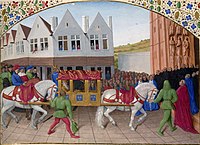
|

|

|

|
Examples of the use of the golden ratio in Fouquet's paintings. Charles IV and his son Wenceslaus are received in Paris (Grandes Chroniques de France, fol. 442v); Crucifixion scene (Book of Hours by Étienne Chevalier); Portrait of the fool Gonella
Even if there are no documents on Fouquet's art theoretical considerations, it is certain that Fouquet consciously used the golden ratio in the construction of the image. The constant division of areas or stretches at a ratio of 1.618: 1 was a traditional ordering principle that was widely used in Gothic art, but gained new relevance in the Renaissance. This principle, for example, almost systematically organizes the picture surfaces in the Grandes Chroniques de France . It is extremely difficult to prove the use of the golden ratio in retrospect, but the discovery of a piercing hole of the compass on Folio 441 of the Grandes Chroniques at exactly the predictable point leaves no doubt as to the construction of the image using the golden ratio.
However, Fouquet did not use the golden ratio rigidly and consistently, but rather as one of several tools for creating images. In many compositions there is no recognizable geometric principle of order, but some also follow simpler, traditional design patterns.
Antiquarian accuracy and documentary observation skills
In his miniatures in particular, Fouquet incorporated an abundance of details from history and from his immediate surroundings. While artists of earlier generations almost always painted typical architectural backgrounds in general, Fouquet documented the cities of Paris and Tours in particular down to the last detail.
In the case of religious and historical texts that Fouquet illustrated in particularly large numbers, the precise reading of the texts is noticeable, often supplemented by other sources so that details of the representations can go beyond the content of the text passage to be illustrated. In this way, Fouquet invented unusually creative pictorial motifs, which, in contrast to the practice of most medieval artists, make relatively little use of traditional iconographic patterns.
Fouquet successfully endeavored to introduce a new principle of order into painting that combines dynamism and calm, especially in crowd scenes. Particularly in multi-figure battle scenes, he overcame the usual additive process and instead used very moving figures that can overlap the edge of the picture and avoid a uniform central perspective. New motifs include the fallen rider, horse studies or the Clipeus motif.
The portrayals of people are also an expression of Fouquet's great power of observation. His portraits as well as group and crowd scenes are extremely lively. It is noticeable that Fouquet treats large-format panel paintings and small miniatures only slightly differently. Fouquet paid particular attention to the representation of horses, which, however, is repeated very often, which indicates the use of pattern books , which Fouquet must have created after his own study of nature.
Fouquet's role as a documentary of his time is fully evident in the representations of current events. On the famous miniature with the gathering of the Lit de justice de Vendôme in Munich's Boccaccio (see illustration above), not only numerous participants can be identified by the quality of the portraits. One of the figures - the only one looking at the viewer - is considered to be Fouquet's self-portrait and thus gives the representation authenticity. In fact, Fouquet must have been present at the trial. In the Grandes Chroniques de France , Fouquet depicts several royal entrances in great detail and vividly, of which he was undoubtedly a witness.
Art of narration
In his book illuminations, Fouquet often inserted small pictures into larger pictures in such a way that they are completely integrated into the action as picture objects. Likewise, the beginnings of text often become part of the picture's reality as written tablets. The main and secondary scenes as well as the beginning of the text thus form an overall picture.
Fouquet particularly often used the form of simultaneous representation, which stages an event in several phases. Often the view into buildings is free, which Fouquet presents openly to the viewer. Contemporary mystery games can have had an important influence on Fouquet's narrative pictorial compositions, which of course can hardly be reliably verified.
reception
Controversial and lost works
As early as 1903 Bouchot compiled a list of later drawings and engravings that could have been copies of lost Fouquet pictures. He suspected that a chalk drawing by Agnès Sorel from the 15th century was such a tracing. Most of these copies are portraits from the royal court: Jacques Cœur , Jean Bureau , Jean Bourré , two drawings by Guillaume Juvénal des Ursins and four King Louis XI.
Several of Fouquet's pictures can only be deduced from written sources: An Assumption of Mary in Candes for Archbishop Jean Bernard, a picture of the Madonna for the Cathedral of Tours, Imagines sanctorum in the Church of Notre-Dame in La Riche , designs for Mystery Plays , coats of arms for Michael Order (1469/70), the decoration of the canopy for the solemn entry of King Alfonso V of Portugal (1476) and a Madonna tondo in a case in the Margaret of Austria collection .
The illuminations in particular were affected by the scientific dispute about Fouquet's authorship. Since the 1970s, Eberhard König has been working intensively to organize the increasingly numerous manuscripts that were ascribed to Fouquet, and to ensure that the manuscripts are divided precisely. Fouquet's attributions for about ten large-format pictures could not prevail or have definitely been abandoned.
Early art literature
Fouquet was praised very early in France and Italy. Filarete and Vasari mentioned his portrait of Pope Eugen IV and admired his art of painting from nature.
Jean Lemaire des Belges praised Fouquet in 1503 in the Plainte du Désiré . François Robertet compared him to Apelles , but also to Jan van Eyck , Simon Marmion , Roger van der Weyden and Hugo van der Goes . Jean Pèlerin Viator equated him with Apelles and Zeuxis in 1521 .
Research history
As early as 1838 the editor of the Grandes Chroniques , Paulin Paris, published the illustrations for the manuscript fr. 6465 in connection with Jean Fouquet and relied on Count Auguste de Bastard. In 1868, Leopold Deslile again attributed the illustrations to Fouquet, but it was only after Henri Bouchot devoted an article of his own to the manuscript in the magazine Gazette des Beaux-Arts in 1890 and published the first illustration of a miniature that the illustrations were finally included in Fouquet's catalog raisonné. This judgment was soon confirmed by the eminent art historian Paul Durrieu . From the beginning there was disagreement over the question of whether all or only some of the miniatures can be attributed to Fouquet.
The first comprehensive publication on Fouquet was presented by Curmer in 1866/67. Around the turn of the century, the first systematic, style-critical representations of the complete works of P. Leprieur and G. Lafenestre followed, which H. Bouchot pursued. As early as 1861 A. de Montailon had recognized that Fouquet must have been in Rome between 1443 and 1447. In 1904, a large exhibition in the Louvre on the Primitifs francais Fouquet became the focus of greater interest for the first time. Until 1923 it was Paul Durrieu in particular who promoted Fouquet research. Soon after the turn of the century, a large part of Fouquet's oeuvre was made accessible.
Otto Pächt has dealt with Fouquet since the 1930s and published a fundamental essay on his style in 1941. In 1974 he was able to convince the professional world to ascribe the Viennese Gonella portrait to Fouquet.
In 1970 Klaus Schwager presented an important essay on Fouquet's lost portrait of Pope Eugene IV in S. Maria sopra Minerva in Rome, which served as the decisive model for Raphael's group portrait of Pope Leo X with the cardinals Giulio de'Medici and Luigi de Rossi from 1517/18 is determined.
In 1993, François Avril , who edited the Grandes Chroniques de France together with Marie-Thérèse Gousset and Bernard Guenée in 1987 , and Nicole Reynaud conceived a major exhibition on French illumination between 1440 and 1520, which Fouquet also extensively appreciated. The exhibition and the published catalog coincided with the printing of the most comprehensive monograph on Jean Fouquet to date, in which Claude Schaefer summarized his decades of work with the painter. In 1971 Schaefer had published Etienne Chevalier's book of hours and in 1972 completed his habilitation with a thesis on Fouquet. François Avril published an equally extensive and detailed monograph on Fouquet in 2003.
Exhibitions
- 2017: Jean Fouquet. The diptych of Melun . Gemäldegalerie at the Kulturforum Berlin . Catalog.
Catalog raisonné
Information according to Claude Schaefer. There you will also find details of the often controversial attributions and dates, which are only given here in abbreviated form. Uncertain attributions are marked with *, lost images are in italics . The nine works from the Fouquet area, also listed by Schaefer, are not listed, five stained glass windows that were executed according to his designs, ten controversial or definitely abandoned attributions, later pictures and engravings based on lost pictures by Fouquet, and written sources, the other eight Pictures of Fouquets attest. In addition, Schaefer lists a number of illuminations from the Fouquet area.
Panel paintings
| Illustration | designation | Dating | Repository | description |
| Portrait of the court jester Gonella | probably between 1439 and 1446 | Vienna, Kunsthistorisches Museum Vienna | Oak wood, 24 × 36 cm | |
| Portrait of Pope Eugene IV with two confidants | between mid-1446 and mid-1448 | lost, formerly above the door of the sacristy of Santa Maria sopra Minerva in Rome; only received in two copies | ||
| Diptych of Melun, left wing | around 1456 | Berlin, Gemäldegalerie | Oak wood, 93 × 85 cm | |
| Melun diptych, right wing | around 1456 | Antwerp, Royal Museum of Fine Arts | Oak wood, 91.8 × 83.3 cm | |
| Portrait of Charles VII | around 1450 | Paris, Louvre | Oak wood, 86 × 71 cm | |
| Pietà in Nouans-les-Fontaines | around 1450 | Nouans-les-Fontaines | Walnut, 146 × 237 cm | |
| Portrait of Guillaume Juvénal des Ursins | probably after 1465 | Paris, Louvre | Oak boards, 96 × 73 cm | |
| Portrait of Louis XI. * | Location unknown, formerly Saint Roch Castle | Oak wood, 22 × 15 cm | ||
| Portrait of Marie d'Anjou | Copy in Paris, Bibliothèque nationale de France, Estampes, Oa 14, fol. 15th |
Drawings, enamel medallions, designs for stained glass windows and tapestries
| Illustration | designation | Dating | Repository | description |
| The Battle of Formigny * | between 1453 and 1455 | Paris, Bibliothèque nationale de France , ms. fr. 22335 | A six-part series of tapestries by the carpenter Gobert | |
| Self-portrait | around 1456 | Paris, Louvre | Enamel medallion, formerly on the frame of the Melun diptych | |
| The winged deer * (design attributed to Fouquet) | Rouen, Musée des antiquités | Tapestry, 3.47 × 3.80 m | ||
| A papal legate | New York, Metropolitan Museum , Rogers Fund 49, 38 | Metal pen and stone chalk on primed paper, 19.8 × 13.5 cm. | ||
| Portrait of Guillaume Jouvenel des Ursins | Berlin, Kupferstichkabinett , 4367 | Stone chalk with red, brown and yellowish red highlights on gray-blue primed paper, 26.7 × 19.5 cm. | ||
| Laurens Girard's monogram * | Paris, Musée National du Moyen Âge | Round disc |
Book illumination
| Illustration | designation | Dating | Repository | description |
| Book of hours for the use of Angers | around 1455 | Paris, Bibliothèque nationale de France , lat. 3211 | (Two miniatures by Fouquet's hand (p. 67 and p. 241), the rest by the Jouvenel painter) | |
| Book of hours of Etienne Chevalier | After 1448 | Chantilly , Musée Condé, London, British Library, Add. 37421; New York, Metropolitan Museum; Paris, Bibliothèque nationale de France, lat. 1416; Paris, Louvre, Departement des Arts graphiques, RF 1679, MI 1093; Paris, Musée Marmottan; Upton House, Lord Bearsted (National Trust); 47 trimmed miniatures and two text sheets preserved | ||
| Book of hours of the Adélaïde of Savoy | Around 1455 to 1460 | Chantilly, Condé Museum, Ms. 76 | ||
| Book of hours for the use of Paris | around 1416/1418 | London, British Library, Add. 16997 fol. | Illustrations by the Boucicaut master retouched by Fouquet | |
| Book of hours of Simon de Varie | Around 1455 | The Hague, Koninklijke Bibliotheek , ms. 74 G 37 and ms. 74 G 37a ; Malibu, J. Paul Getty Museum , ms. 7th | ||
| Grandes Chroniques de France | About 1450-1460 | Paris, Bibliothèque nationale de France, fr. 6465 | 457 sheets; 460 x 350 mm; 51 miniatures (2 lost) | |
| Boccaccio , Des Cas des Malheureux Nobles Hommes et Femmes | around 1459 | Munich, Bavarian State Library , cod. gall. 6th | 352 sheets; 400 × 290 mm; 1 full-page panel, 10 large and 80 small miniatures, numerous borders | |
| Book of hours by Jean Robertet | Around 1460–1465 | New York, Pierpont Morgan Library , M. 834 | ||
| Book of hours | The Hague, Koninklijke Bibliotheek, ms. 74 G 28 | |||
| Book of hours of Charles de France | Before 1465 | Paris, Bibliothèque Mazarine , ms. 473; New York, The Cloisters, 2, cut sheets, 58.71a, b | ||
| Flavius Josephus , Les Antiquités judaïques | Around 1465 | Paris, Bibliothèque nationale de France, ms. fr. 247 | 623 sheets (2 volumes); 430 × 290 mm; 11 large miniatures | |
| Flavius Josephus, Les Antiquités judaïques | Paris, Bibliothèque nationale de France, na fr. 21013 | |||
| Statutes of the Order of St. Michael | Probably 1469 | Paris, Bibliothèque nationale de France, ms. fr. 19819 | ||
| So-called. Livy of the Sorbonne | Paris, Bibliothèque nationale de France, fr. 20071 and 20072 | |||
| Ancient history | after 1470 | Amsterdam, Rijksprentencabinet , Inv. A 1943 (a); Paris, Louvre, Département des Arts graphiques, RF 4143, 5271, 29493 and 29494 (de) (Five sheets) | ||
| So-called. Book of hours of Anne de Baudricourt | Paris, Bibliothèque nationale de France, lat. 3187 | |||
| So-called. De Veauce Book of Hours | Amsterdam, Bibliotheca Philosophica Hermetica , BPH 74 | |||
| Book of hours for the use of Tours | Formerly the Metcalf collection, 247 fol., Today's location unknown | |||
| Book of Hours for the Use of Maine | Around 1480 | Paris, Bibliothèque de l'Arsenal , ms. 417 89 fol. |
literature
- François Avril (Ed.): Jean Fouquet. Peintre et enlumineur du XVe siècle. Exhibition catalog Bibliothèque Nationale de France. Paris 2003, ISBN 2-7177-2257-2 .
- Claude Schaefer: Jean Fouquet. On the threshold of the renaissance. Verlag der Kunst, Dresden 1994, ISBN 3-364-00306-8 .
- The pictures of the Grandes Chroniques de France . With contributions by François Avril, Marie-Thérèse Gousset and Bernard Guenée. With the original reproduction of all 51 miniatures from Manuscrit français 6465 of the Bibliothèque nationale in Paris and 60 black and white illustrations. Academic Printing and Publishing Company, Graz 1987, ISBN 3-201-01381-1 .
- Klaus Schwager: About Jean Fouquet in Italy and his lost portrait of Pope Eugene IV. In: Argo. Festschrift for Kurt Badt on his 80th birthday on March 3, 1970, ed. v. Martin Gosebruch and Lorenz Dittmann, Cologne 1970, pp. 206-234
- Eberhard König: French illumination around 1450. The Jouvenel painter, the painter of the Geneva Boccaccio and the beginnings of Jean Fouquet. Mann, Berlin 1982, ISBN 3-7861-1311-4 .
- Otto Pächt : Jean Fouquet, a study of his style. In: Journal of the Warburg and Courtauld Institutes. 4.1940 / 41, pp. 85-102.
- Claude Schaefer (Ed.): The Book of Hours of Etienne Chevalier. Praeger, Munich a. a. 1971, ISBN 3-7796-8502-7 .
- Paul Wescher: Jean Fouquet and his time , Holbein-Verlag, Basel 1945.
Web links
- Jean Fouquet. Biographical data and works in the Netherlands Institute for Art History (Dutch)
- Literature by and about Jean Fouquet in the catalog of the German National Library
- Exhibition of the Bibliothèque nationale de France (French)
- "Münchner Boccaccio" digitized version of the Bavarian State Library - BSB Cod.gall. 6th
Individual evidence
- ^ "Jean Fouquet, Natif de Tours" in Paris, Bibliothèque nationale de France, ms. fr. 247, nouv. acqu. 21013, quoted from C. Schaefer 1994, p. 352.
- ↑ Especially P. Durrieu: La question des œuvres de jeunesse de Jean Fouquet. In: Recueil de mémoires publié par la Société nationale des Antiquaires de France à l'occasion de son centenaire. Paris 1904, pp. 111–119 and E. König 1982.
- ↑ King 1982.
- ↑ Schaefer 1994, p. 21.
- ^ Attribution since O. Pächt , Die Autorschaft des Gonella-Bildnis. In: Yearbook of the Art History Collection in Vienna , 1974, pp. 39–88.
- ↑ See Otto Pächt 1974 or Claude Schaefer or Schaefer 1994, p. 21ff.
- ↑ Schaefer 1994, p. 277, etc.
- ↑ A weighing of the theories put forward in research can be found in Schaefer 1994, p. 18.
- ↑ See Schaefer 1994, p. 18.
- ↑ Schaefer 1994, p. 27.
-
↑ Commons : The Book of Hours of Étienne Chevalier - Collection of images, videos and audio files
- ^ So Schaefer 1994, p. 307.
- ↑ Schaefer 1994, p. 307.
- ↑ Representing E. König 1989, Col. 676.
- ↑ from Latin 1416.
- ^ Department des Arts graphiques, RF 1679.
- ↑ Add. 37421.
- ↑ Collection Lord Bearsted.
- ↑ Schaefer 1994, pp. 306-308.
- ↑ Printed in Schaefer 1993, p. 346.
- ↑ a b See Schaefer 1994, p. 153.
- ↑ Schaefer 1994, p. 293.
- ↑ For example Joris-Karl Huysmans in his novel Là-bas (1891)
- ↑ Schaefer 1993, pp. 153f.
- ↑ This connection was first recognized by N. Reynaud, exhibition catalog Jean Fouquet , 1981, p. 17.
- ^ P. Vitry, La Pitié de Nouans. In: Gazette des Beaux-Arts I (1932), pp. 254ff.
- ^ So Paul Wescher, Jean Fouquet und seine Zeit , 1945, p. 52.
- ↑ So Ch. Sterling 1946, p. 128.
- ^ C. Gilbert, review S. Orlandi, Beato Angelico , 1965, p. 273.
- ^ So Schaefer 1994, p. 163.
- ^ L. Marrow, Miniatures inédites de Jean Fouquet. Les Heures de Simon de Varie. In: Revue de l'art 67 (1985), pp. 3-28; Pictures with brief introductions on the Getty Museum website ( memento of the original from September 20, 2006 in the Internet Archive ) Info: The archive link has been inserted automatically and has not yet been checked. Please check the original and archive link according to the instructions and then remove this notice. .
- ↑ Pictures with short introductions on the website of the Koninklijke Bibliotheek ( Memento of the original of August 9, 2007 in the Internet Archive ) Info: The archive link has been inserted automatically and has not yet been checked. Please check the original and archive link according to the instructions and then remove this notice. .
- ↑ After a dendrochronological examination, the wooden panel could be painted from 1456 onwards. See P. Klein, Dendrochronological studies on panels by Jean Fouquet. In: ICOM Committee for Conservation, 7th Triennial Meeting, Copenhagen, 10. – 14. September 1984.
- ↑ “Some think that the portrait was painted after the features of Agnès Sorel.” D. Godefroy, Histoire de Charles VII , Paris 1661. Translation after Schaefer 1994, p. 146.
- ↑ Rose-Marie and Rainer Hagen: The king's mistress poses as mother Maria. In: Masterpieces in Detail , Volume 2, p. 56, Taschen Verlag, Cologne a. a. 2003.
- ↑ Hagen, p. 56.
- ↑ Schaefer 1994, pp. 145ff.
- ↑ Schaefer 1994, p. 139.
- ^ P. Klein, Dendrochronological studies on panels by Jean Fouquet. In: ICOM Committee for Conservation, 7th Triennial Meeting, Copenhagen, 10. – 14. September 1984.
- ^ D. Godefroy, Histoire de Charles VII, Roy de France, Sous-Chantre de S. Denys , Paris 1661. Reprinted in C. Schaefer, p. 356.
- ^ The dating according to Avril 1987, p. 16f.
- ^ Bavarian State Library, Cod. Gall. 6. See Avril 1987, p. 17.
- ↑ See Avril 1987, pp. 16f.
- ↑ Schaefer 1994, p. 180f.
- ↑ See Schaefer 1994, p. 199.
- ↑ Printed in Schaefer 1994, p. 350.
- ↑ Schaefer 1994, p. 298.
- ^ Max Friedländer, A portrait study by Jean Fouquet. In: Yearbook of the Royal Prussian Art Collections, Berlin 1910, pp. 227–230.
- ^ Printed in full in Schaefer 1994, pp. 352f.
- ^ So Schaefer 1994, p. 232ff.
- ↑ This was already suspected by Paul Durrieu, Une peinture historique de Jean Fouquet. In: Gazette archéologique, 1890, p. 61ff.
- ^ Marie-Thérèse Gousset in: Die Bilder der Grandes Chroniques de France 1986, p. 33ff.
- ↑ This is a basic thesis from Schaefer 1994.
- ^ H. Bouchot, De quelques portraits du peintre Jean Fouquet aujourd'hui perdu. In: Revue de l'art ancien et moderne, 1903, pp. 1–22; also in Schaefer 1994, p. 296ff.
- ^ A compilation in Schaefer 1994, p. 299 with reference to the edited documents in the same work.
- ↑ Especially: Eberhard König, French book painting around 1450 , Berlin 1982.
- ↑ See Schaefer 1994, p. 303.
- ^ Trattato dell'archittetura (1451). Quoted in Schaefer 1994, p. 345.
- ↑ Vite (1550). Quoted in Schaefer 1994, p. 345.
- ↑ Les Grandes Chroniques de France , ed. v. Paulin Paris, Vol. 5, Paris 1838, p. 500.
- ↑ Le Cabinet des Manuscrits de la Bibliothèque impériale , vol. 1, Paris 1868, p. 76, note 3.
- ^ H. Bouchot: Jean Fouquet. In: Gazette des Beaux-Arts 1890, Vol. 2, pp. 418-420.
- ^ P. Durrieu: Une vue intérieure de l'ancien Saint-Pierre de Rome peinte par Jean Fouquet. In: Mélanges GB de Rossi , ed. v. the École française de Rome, Rome 1892, pp. 221-235.
- ↑ See F. Avril, p. 14.
- ^ Léon Curmer, Oeuvre de Jehan Foucquet , 2 volumes, Paris 1866–1867.
- ^ P. Leprieur, Jean Fouquet. In: Revue de l'art anc. et mod. 1897, I, pp. 25-41, II, pp. 15-29, 146-160, 347-359.
- ^ G. Lafenestre, Jean Fouquet , Paris 1905.
- ↑ u. a. H. Bouchot, Jean Fouquet. In: Gazette des beaux-arts. 3e période, t. IV, 1890, pp. 237-281 and 416-426.
- ↑ A. de Montailon, Jehan Foucquet et son portrait du pape Eugène IV d'après les témoignages d'Antonio Filarete et de Vasari. In: Archives de l'artfrançaise. 2e série I, 1861, pp. 454-468.
- ↑ u. a. Paul Durrieu, Les Antiquités judaïques et le peintre Jean Fouquet , Paris 1908; ders., Le Boccace de Munich , Munich 1909.
- ↑ Otto Pächt, Jean Fouquet. A study of his style. In: Journal of the Warburg and Courtauld Institutes. vol. IV, 1940-1941, pp. 85-102.
- ↑ Otto Pächt, The authorship of the Gonella portrait. In: Yearbook of the Art History Collections in Vienna. 1974, t. 70, pp. 39-88.
- ↑ Klaus Schwager, About Jean Fouquet in Italy and his lost portrait of Pope Eugene IV. In: Argo. Festschrift for Kurt Badt on his 80th birthday on March 3, 1970 , ed. v. Martin Gosebruch and Lorenz Dittmann, Cologne 1970, pp. 206-234.
- ↑ Avril 1987.
- ↑ Catalog Les manuscrits à peintures en France. 1440-1520. Paris 1993.
- ↑ Schaefer 1994.
- ^ Claude Schaefer (ed.): The book of hours of Etienne Chevalier. Munich u. a., Praeger 1971.
- ^ C. Schaefer: Recherches sur l'iconologie et la stylistique de l'art de Jean Fouquet. Lille 1972.
- ↑ Avril 2003.
- ↑ Claude Schaefer 1994, pp. 289ff.
| personal data | |
|---|---|
| SURNAME | Fouquet, Jean |
| BRIEF DESCRIPTION | French book and panel painter |
| DATE OF BIRTH | around 1420 |
| PLACE OF BIRTH | Tours |
| DATE OF DEATH | around 1480 |

